When a miniature control system is a must, along with a variety of I/O options, customers choose Micromint's RTC stacking-board product line as a proven performer. With our complete line of development system tools, using them is as simple as R-T-C.
RTC controllers can be used stand alone or in a stacked architecture consisting of a base processor with a variety of I/O expansion boards. Together, they can provide a collective control solution in as small as a 3.5" x 3.5" footprint.
Users choose among six different processor types for their favorite programming environment. Then, if the processor board's considerable onboard I/O isn't enough, they choose from more than a dozen different I/O expansion boards to add on top of the processor boards. Whatever the application, whatever the voltage and I/O constraints, a Micromint RTC stack results in an unbeatable price-performance package every time.
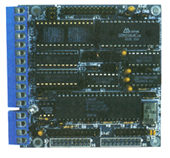
The RTC31/52 is our all-time best price-performer. The RTC31 is a 3.5" x 3.5" real-time controller that uses an 8031 processor and is intended for OEM assembly-language applications. The RTC52 uses the same PC board but has a Micromint 80C52-BASIC processor instead of an 8031. With BASIC, the RTC52 is software compatible with our BCC52 series, as well as allowing for onboard program development using a common RS-232 terminal. The 80C52-BASIC processor can also be jumper-selected to function as an 80C31/80C32 processor.
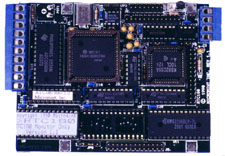
Take an advanced, new-generation microprocessor, make it completely software compatible with one of the industry's most respected microprocessors, put it in a compact, low-power package, and what do you have? You have an OEM's dream! You also have the RTC180, a member of our amazing RTC family that has an installed base of thousands.
The RTC180 uses the Zilog Z180 processor, an established favorite of application design engineers worldwide. The RTC180 provides plenty of memory with 96 KB of system memory: 32-KB SRAM and either 32-KB SRAM plus 32-KB EPROM or 64-KB EPROM, plus 128 bytes of configuration EEPROM. The RTC180's onboard I/O is impressive as well, with two serial ports (one full-duplex RS-232 and one half-duplex RS-485), 24 bits of TTL parallel I/O, and an 8-channel 8-bit ADC. The RTC180 wraps all of this power and versatility into the 3.5" x 4.5" RTC form factor.
Learn More...
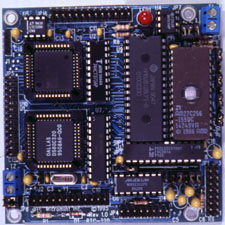
One of Micromint's hottest-selling products for the past five years has been the RTC31/52 stackable controller. It has been a leading price/performance choice among our customers. With our new RTC320 and RTC52-Plus boards, we have expanded the value of that relationship even more.
Occupying the same small 3.5" x 3.5" RTC footprint and 5-V-only power, the RTC320 uses the new Dallas Semiconductor 80C320, which is 8031 code-compatible and 35 times faster. At 33 MHz, the RTC320 is an 8-MIPS controller! Along with the new powerful processor, the RTC320 board accommodates up to 192 KB of memory, 2 serial ports (RS-232 and RS-485), 24 bits of TTL parallel I/O, and a 2-channel 12-bit ADC. The RTC320 puts some real firepower under the abundant variety of RTC I/O expansion boards. Plugging in your favorite ICE or EPROM emulator is the easiest way to develop code. For the diehards who like to twiddle the bits directly, we have a ROM monitor specifically designed for the Dallas '320.
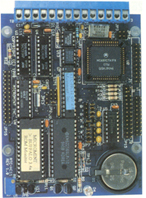
Offering exceptional value in a single-board embedded controller, our RTC-HC11 combines all of the most-asked-for features into a small 3.5" x 4.5" package at a reasonable price. Featuring the popular Motorola MC68HC11 microcontroller, the RTC-HC11 gives you an exceptional list of specifications at a very affordable price.
Software development can be done directly on the RTC-HC11 target system using assembly language or BASIC-11, an extremely fast integer BASIC interpreter with dedicated keywords for I/O port, A/D converter, timer, interrupt, and EEPROM support. In addition, a BASIC program can be saved on the onboard battery-backed static RAM or burned into an autostarting EPROM.
Processor Boards Expansion Boards
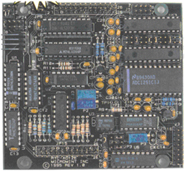
The RTC-AD12E is our newest addition to the RTC line. It is affered in 3 configurations, the EA, EB and ED versions. The EA version offers an 8-channel (4-channel differential) 12 bit analog-to-digital converter. The EB version includes the 4-channel digital-to-analog converter for the RTC bus. The ED version offers only the DAC. Perfect for those applications that involve more meticulous data collection, this peripheral board is the culmination of high performance and compact packaging.
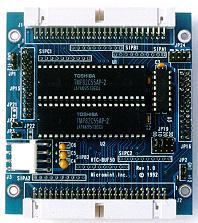
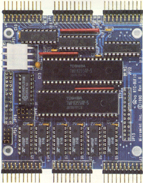
The RTC-BUFIO is a buffered, high-voltage, digital input/output expansion board designed to directly power external devices (such as relays and indicators) and protect digital inputs from real-world interfacing anomalies.
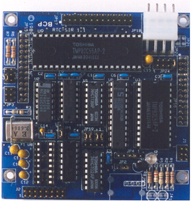
RTC-SIR is a multifunction expansion board offering a combination of four independent I/O subsystems: bidirectional TTL parallel I/O, RS-232 serial I/O, infrared transmit and receive, and 16-bit programmable timers.
RTC controllers can be used stand alone or in a stacked architecture consisting of a base processor with a variety of I/O expansion boards. Together, they can provide a collective control solution in as small as a 3.5" x 3.5" footprint.
Users choose among six different processor types for their favorite programming environment. Then, if the processor board's considerable onboard I/O isn't enough, they choose from more than a dozen different I/O expansion boards to add on top of the processor boards. Whatever the application, whatever the voltage and I/O constraints, a Micromint RTC stack results in an unbeatable price-performance package every time.
Processor Boards
RTC31/52

The RTC31/52 is our all-time best price-performer. The RTC31 is a 3.5" x 3.5" real-time controller that uses an 8031 processor and is intended for OEM assembly-language applications. The RTC52 uses the same PC board but has a Micromint 80C52-BASIC processor instead of an 8031. With BASIC, the RTC52 is software compatible with our BCC52 series, as well as allowing for onboard program development using a common RS-232 terminal. The 80C52-BASIC processor can also be jumper-selected to function as an 80C31/80C32 processor.
The RTC31/52 was designed to provide a minimal configuration for cost-conscious applications. It can be greatly expanded to perform more extensive control and data-acquisition tasks while maintaining the same small 3.5" x 3.5" footprint by using a stacked-board expansion system. Additional analog and digital I/O boards are piggybacked on top of the processor board and secured with stand-offs.
RTC180

Take an advanced, new-generation microprocessor, make it completely software compatible with one of the industry's most respected microprocessors, put it in a compact, low-power package, and what do you have? You have an OEM's dream! You also have the RTC180, a member of our amazing RTC family that has an installed base of thousands.
The RTC180 uses the Zilog Z180 processor, an established favorite of application design engineers worldwide. The RTC180 provides plenty of memory with 96 KB of system memory: 32-KB SRAM and either 32-KB SRAM plus 32-KB EPROM or 64-KB EPROM, plus 128 bytes of configuration EEPROM. The RTC180's onboard I/O is impressive as well, with two serial ports (one full-duplex RS-232 and one half-duplex RS-485), 24 bits of TTL parallel I/O, and an 8-channel 8-bit ADC. The RTC180 wraps all of this power and versatility into the 3.5" x 4.5" RTC form factor.
Learn More...
RTC-320/52Plus

One of Micromint's hottest-selling products for the past five years has been the RTC31/52 stackable controller. It has been a leading price/performance choice among our customers. With our new RTC320 and RTC52-Plus boards, we have expanded the value of that relationship even more.
Occupying the same small 3.5" x 3.5" RTC footprint and 5-V-only power, the RTC320 uses the new Dallas Semiconductor 80C320, which is 8031 code-compatible and 35 times faster. At 33 MHz, the RTC320 is an 8-MIPS controller! Along with the new powerful processor, the RTC320 board accommodates up to 192 KB of memory, 2 serial ports (RS-232 and RS-485), 24 bits of TTL parallel I/O, and a 2-channel 12-bit ADC. The RTC320 puts some real firepower under the abundant variety of RTC I/O expansion boards. Plugging in your favorite ICE or EPROM emulator is the easiest way to develop code. For the diehards who like to twiddle the bits directly, we have a ROM monitor specifically designed for the Dallas '320.
RTC-HC11

Offering exceptional value in a single-board embedded controller, our RTC-HC11 combines all of the most-asked-for features into a small 3.5" x 4.5" package at a reasonable price. Featuring the popular Motorola MC68HC11 microcontroller, the RTC-HC11 gives you an exceptional list of specifications at a very affordable price.
Software development can be done directly on the RTC-HC11 target system using assembly language or BASIC-11, an extremely fast integer BASIC interpreter with dedicated keywords for I/O port, A/D converter, timer, interrupt, and EEPROM support. In addition, a BASIC program can be saved on the onboard battery-backed static RAM or burned into an autostarting EPROM.
Processor Boards Expansion Boards
Expansion Boards
RTC-AD12E

The RTC-AD12E is our newest addition to the RTC line. It is affered in 3 configurations, the EA, EB and ED versions. The EA version offers an 8-channel (4-channel differential) 12 bit analog-to-digital converter. The EB version includes the 4-channel digital-to-analog converter for the RTC bus. The ED version offers only the DAC. Perfect for those applications that involve more meticulous data collection, this peripheral board is the culmination of high performance and compact packaging.
The RTC-AD12E’s 12-bit-plus-sign A/D converter performs more than 20,000 conversions per second within an input range of -5V to+5V. The ADC incorporates special input overvoltage protection and input scaling which is especially useful for low-level signals or high-noise environments. Each channel is independently gain programmable for 1, 2, 4, or 8 times gain. The RTC-AD12E also has four buffered, fast-action DAC outputs. Each channel can have separate output scaling.
RTC-BUF50

The RTC-BUF50 is a TTL-level digital input/output expansion board with 48 TTL-level I/O lines that are selected as six 8-bit I/O ports. These six ports may be configured as any combination of inputs and outputs.
Two industry-standard 50-pin ribbon cable headers provide external connections to typical Opto-22-type expansion interface boards such as the IDI24 (optoisolated DC input) and IDO24 (contact-closure relay output).
RTC-BUFIO

The RTC-BUFIO is a buffered, high-voltage, digital input/output expansion board designed to directly power external devices (such as relays and indicators) and protect digital inputs from real-world interfacing anomalies.
RTC-BUFIO offers a total of 48 I/O lines: 24 high-voltage buffered input lines which easily withstand –30V to + 30V input voltages, and 24 digital driver output lines that provide as much as 1/2A driving current for lamps and relays. Six 2x10 ribbon cable headers are provided for external connections to the six 8-bit I/O ports.
RTC-SIR

RTC-SIR is a multifunction expansion board offering a combination of four independent I/O subsystems: bidirectional TTL parallel I/O, RS-232 serial I/O, infrared transmit and receive, and 16-bit programmable timers.
The parallel I/O consists of 24 bits of TTL from an 8255 PPI. The RS-232 serial I/O consists of an independent UART and timebase which provide all standard data rates from 50 to 38,400 bps. The onboard infrared transceiver consists of a 40-kHz modulated or digital on/off infrared transmitter and 40-kHz fixed-frequency receiver.
Finally, for precision timing, the RTC-SIR is fitted with the 8254 programmable timer, giving it three independent 16-bit binary or BCD counter/timers.






